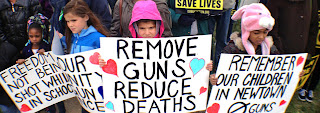The beam from the intruder's flashlight pierced the blackness of the
bedroom at 4:45 a.m., sweeping across the down comforter and into Eric Martin's
eyes. Outside, the streets of his Utah subdivision lay still and silent.
But as Martin rolled to the floor, reached into the nightstand drawer
and drew out his 9 mm pistol, the 46-year-old executive's mind raced with
calculation: Would this man harm Martin's fiancee or her son? Was an accomplice
outside waiting? What if he pulled the trigger and hit the sleeping 8-year-old
across the hall?
In the weeks since the Connecticut school massacre, some of the most
intense debate has swirled around how to keep guns from criminals without
infringing on the ability of lawful gun owners, like Martin, to protect
themselves and their families.
Indeed, protection is now the top reason gun owners cite for having a
firearm, a new survey shows, a figure that has nearly doubled since 1999.
But even after years of study, there is little clarity on how, exactly,
Americans use guns to protect themselves in moments of jeopardy — or how often.
Researchers known for sharp disagreement on the self-defense riddle say the
answers may be shifting dramatically because of a steep drop in crime, an
increase in guns and state laws giving owners more leeway to wield them.
Determining the absolute value of guns for self-defense is clouded by
that complex dynamic of policy, judgment and circumstance. Still, both
advocates of gun rights and of gun control understand the issue's importance in
shaping the debate.
"When there's a threat outside your door, the police aren't going
to be there ... the guys trained to save lives aren't going to be there,"
said Dom Raso, a commentator for the National Rifle Association's online news
channel, in a video posted recently by the gun rights group.
And even while calling for new gun laws, President Barack Obama, too,
acknowledged the legitimacy of self-defense in an April 8 speech in Hartford,
Conn., when he recounted a conversation with his wife, Michelle, after
campaigning in rural Iowa.
"Sometimes it would be miles between farms, let alone towns,"
Obama said. "And she said, 'You know, coming back, I can understand why
somebody would want a gun for protection. If somebody drove up into the
driveway and, Barack, you weren't home, the sheriff lived miles away, I might
want that security.'"
With Americans split over whether guns more often save lives or
jeopardize them, researchers have long parsed surveys of crime victims done in
the 1990s, arguing over what the numbers mean.
But since then, crime has plummeted in the U.S. The rate of violent
crimes including murder and assault fell by nearly half from 1992 to 2011, while
the rate of reported property crime dropped 41 percent, data compiled by the
Federal Bureau of Investigation show.
That drop has researchers considering the possibility, even the
likelihood, that many fewer Americans are drawing firearms to protect themselves.
"I'm pretty confident that whatever the number is, it did go down
... because overall crime went down," said Gary Kleck, a Florida State
University criminologist whose 1990s research, widely cited by gun rights
activists, concluded that Americans drew their firearms in self-defense up to
2.5 million times a year. That translates to about 3 percent of all gun owners
during the course of a single year.


No comments:
Post a Comment